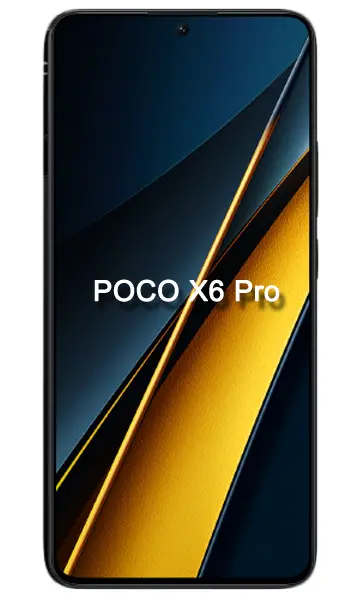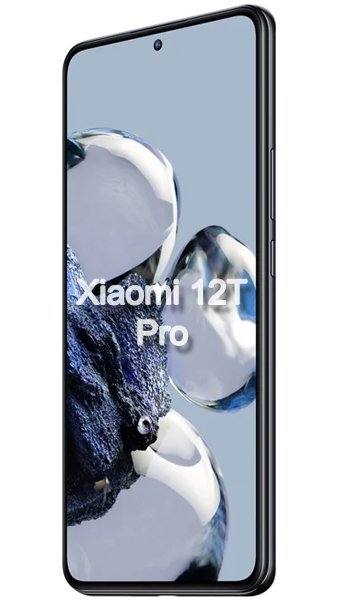Xiaomi Poco X6 Pro vs Xiaomi 12T Pro Comparison and Differences
Smartphone 1

Xiaomi Poco X6 Pro
Smartphone 2

Xiaomi 12T Pro
Smartphone 3
Differences between Xiaomi Poco X6 Pro and Xiaomi 12T Pro - Which to Choose?
Reasons to consider the Xiaomi Poco X6 Pro:
- Newer model with a release date in January 2024 versus October 2022 for the 12T Pro.
- Equipped with HyperOS on top of Android 14, which is a more recent operating system than the 12T Pro's Android 12 with MIUI 13.
- Uses a Mediatek Dimensity 8300 Ultra chipset which may have different performance characteristics compared to the 12T Pro's Snapdragon 8+ Gen 1.
- Features a GPU with Mali G615-MC6 which might offer different graphics performance.
- Offers higher memory options: up to 512GB storage with 12GB RAM compared to the maximum of 256GB storage and 12GB RAM on the 12T Pro.
- Supports more 5G bands, which may result in better 5G connectivity depending on your region.
- Offers a higher peak brightness of 1800 nits compared to 900 nits in the 12T Pro.
- IP54 dust and splash resistance rating, which is slightly better than the 12T Pro's IP53 rating.
- More affordable with a price of 400 EUR as listed.
Reasons to consider the Xiaomi 12T Pro:
- Features a high-resolution 200 MP main camera compared to the 64 MP main camera on the Poco X6 Pro, potentially offering better image quality.
- Possesses a more powerful Qualcomm Snapdragon 8+ Gen 1 chipset, which may provide better overall performance and efficiency.
- Supports faster charging with 120W capability, promising 100% battery in 19 minutes compared to Poco X6 Pro's 67W.
- Equipped with stereo speakers tuned by Harman Kardon, potentially delivering superior audio quality.
- Has a color spectrum sensor which can be used for more accurate color detection in photos.
- Higher AnTuTu Benchmark score which may indicate better overall system performance.
- Supports Wi-Fi 6 with hotspot capability, which the Poco X6 Pro might lack the hotspot feature.
- Record videos in 8K resolution, whereas Poco X6 Pro is limited to 4K recording.
- Constructed with an aluminum alloy frame which might offer a more premium feel and durability.
Both smartphones have their own set of advantages, so the better option depends on what features are more important to the user, such as camera resolution, charging speed, and overall performance.
Xiaomi Poco X6 Pro or Xiaomi 12T Pro Specs Comparison
or
 Common specs
Common specs
| Brand and model | Xiaomi Poco X6 Pro | Xiaomi 12T Pro | |
| Rating | (+0) | (+0) | |
| Release date | 2024, January 11 | 2022, October 04 | |
| Dimensions (HxWxD) | 160.5 x 74.3 x 8.3 mm | 6.32 x 6.32 x 2.93 in | 163.1 x 75.9 x 8.6 mm | 6.42 x 6.42 x 2.99 in | |
| Weight | 186 g | 6.56 oz | 205 g | 7.23 oz | |
| Body Build | Glass front (Gorilla Glass 5), plastic back or silicone polymer back (eco leather) | Aluminium alloy | |
| Case | buy from Amazon | buy from Amazon | |
| Colors | Black, Yellow, Gray | Black, Silver, Blue | |
| Battery | 5000 mAh, Li-Po, non-removable | 5000 mAh, Li-Polymer, non-removable | |
| Approximate price | $ 350 | 650 EUR | |
| Check price | from Amazon | from Amazon |
 Screen
Screen
| Technology | AMOLED | AMOLED | |
| Touchscreen | capacitive touchscreen | capacitive touchscreen | |
| Display colors | 68B | 68B | |
| Screen size | 6.67" in | 6.67" in | |
| Screen area | 107.4 cm2 | 107.4 cm2 | |
| Screen format | 20:9 (height:width) | 20:9 (height:width) | |
| Screen to body ratio | 90.1% | 86.7% | |
| Screen resolution | 1220 x 2712 px | 1220 x 2712 px | |
| Screen PPI /points per inch/ | 446 PPI | 446 PPI | |
| Screen protection | Corning Gorilla Glass 5 | Corning Gorilla Glass 5 | |
| Other specs | - 120Hz, HDR10+, Dolby Vision, 500 nits (typ), 1200 nits (HBM), 1800 nits (peak) - |
- 120Hz -Dolby Vision -HDR10+ -500 nits (typ) -900 nits (peak) |
|
| Screen protector | buy from Amazon | buy from Amazon |
 Camera and Video
Camera and Video
| Rear camera, main | 64 MP, Triple | 200 MP, Triple | |
| Camera specs | -64 MP, f/1.7, 25mm (wide), 1/2.0", 0.7µm, PDAF, OIS -8 MP, f/2.2, 120˚ (ultrawide) -2 MP, f/2.4, (macro) |
-200 MP, f/1.7, (wide), 1/1.22", 0.64µm, PDAF, OIS -8 MP, f/2.2, 120˚ (ultrawide), 1/4", 1.12µm -2 MP, f/2.4, (macro) |
|
| Functions | LED flash, HDR, panorama | Dual-LED dual-tone flash, HDR, panorama | |
| Video | 4K@24/30fps, 1080p@30/60fps, gyro-EIS | 8K@24fps, 4K@30/60fps, 1080p@30/60/120/240fps, HDR10+ | |
| DxOMark Main Score | 129 | ||
| DxOMark Photo | 130 | ||
| DxOMark Video | 134 | ||
| Front camera, selfie | 16 MP, Single | 20 MP, Single | |
| Specifications | 16 MP, f/2.4, (wide), 1/3.06", 1.0µm | 20 MP, f/2.2, (wide), 1/3.47", 0.8µm | |
| Functions | HDR, panorama | HDR, panorama | |
| Video | 1080p@30/60fps | 1080p@30/60fps |
 Performance
Performance
| Operating system - OS | Android 14, HyperOS | Android 12, MIUI 13 | |
| Chipset | - Mediatek Dimensity 8300 Ultra (4 nm) | - Qualcomm SM8475 Snapdragon 8+ Gen 1 (4 nm) | |
| CPU | - Octa-core (1x3.35 GHz Cortex-A715 & 3x3.20 GHz Cortex-A715 & 4x2.20 GHz Cortex-A510) | - Octa-core (1x3.19 GHz Cortex-X2 & 3x2.75 GHz Cortex-A710 & 4x2.0 GHz Cortex-A510) | |
| GPU | Mali G615-MC6 | Adreno 730 | |
| External memory | No | No | |
| Internal memory | 256GB 8GB RAM, 256GB 12GB RAM, 512GB 12GB RAM | 128GB 8GB RAM, 256GB 8GB RAM, 256GB 12GB RAM |
 Benchmark
Benchmark
| Antutu 10 Total | 1433022 | 1317025 | |
| Antutu 10 CPU | 290846 | 361092 | |
| Antutu 10 GPU | 538303 | 477728 | |
| Antutu 10 Mem | 334794 | 226741 | |
| Antutu 10 UX | 290846 | 361092 | |
| Antutu 9 Total | 1072504 | ||
| GeekBench 6 Single Core | 1499 | 1147 | |
| GeekBench 6 Multi Core | 4265 | 3799 | |
| GeekBench 6 OpenCL | 3959 | ||
| GeekBench 6 Vulkan | 5589 | ||
| GeekBench 5 Single Core | 1277 | ||
| GeekBench 5 Multi-Core | 4311 |
 Communication and Connectivity
Communication and Connectivity
| SIM card | Dual SIM (Nano-SIM, dual stand-by) | Nano-SIM and/or eSIM or Dual SIM (Nano-SIM, dual stand-by) | |
| Network | GSM / HSPA / LTE / 5G | GSM / HSPA / LTE / 5G | |
| Bands | -2G - GSM 850 / 900 / 1800 / 1900 - SIM 1 & SIM 2 -3G - HSDPA 850 / 900 / 1700(AWS) / 1900 / 2100 -4G - 1, 2, 3, 4, 5, 7, 8, 18, 19, 20, 28, 38, 40, 41, 48, 66 -5G - 1, 2, 3, 5, 7, 8, 20, 28, 38, 40, 41, 48, 77, 78 SA/NSA/Sub6 |
-2G - GSM 850 / 900 / 1800 / 1900 - SIM 1 & SIM 2 CDMA 800 -3G - HSDPA 800 / 850 / 900 / 1700(AWS) / 1900 / 2100 CDMA2000 1xEV-DO -4G - LTE -5G - SA/NSA |
|
| Speed | HSPA, LTE-A, 5G | HSPA 42.2/5.76 Mbps, LTE-A, 5G | |
| GPRS | Yes | Yes | |
| Edge | Yes | Yes | |
| Wi-Fi | Wi-Fi 802.11 a/b/g/n/ac/6, dual-band, Wi-Fi Direct | Wi-Fi 802.11 a/b/g/n/ac/6, dual-band, Wi-Fi Direct, hotspot | |
| GPS | GPS, GALILEO, GLONASS, QZSS, BDS (B1I+B1c) | GPS (L1+L5), GLONASS (L1), BDS (B1I+B1c+B2a), GALILEO (E1+E5a), QZSS (L1+L5), NavIC (L5) | |
| NFC | Yes (market/region dependent) | Yes (market/region dependent) | |
| USB | USB Type-C 2.0, OTG | USB Type-C 2.0, USB On-The-Go | |
| Bluetooth | 5.4, A2DP, LE, aptX HD | 5.2, A2DP, LE, aptX HD | |
| Harmful irradiation |
SAR - 1.08 W/kg (head) 1.07 W/kg (body) SAR EU - 1.00 W/kg (head) 1.00 W/kg (body) |
 Music and Audio
Music and Audio
| Radio | No | No | |
| Headphone jack | No | No | |
| Others | - 24-bit/192kHz Hi-Res & Hi-Res Wireless audio | - Tuned by Harman Kardon -24-bit/192kHz audio |
 Other features
Other features
| Sensors | - Fingerprint (under display, optical), accelerometer, gyro, compass, proximity , Infrared port | - Fingerprint (under display, optical), accelerometer, gyro, proximity, compass, color spectrum , Infrared port | |
| Other extras |
- 67W Fast charging, QC2.0, PD3.0, 100% in 45 min - IP54, dust and splash resistant |
- Fast charging 120W, 100% in 19 min - IP53, dust and splash resistant |
Reviews and Opinions on Xiaomi Poco X6 Pro and Xiaomi 12T Pro
If you had to recommend one of these phones to a friend, which one would it be and why? Share your arguments using the Add Opinion button!

